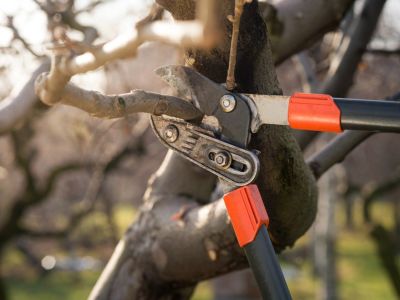For those of you who wonder about the procedure for pruning a tree, read on. We’ll give you the pruning basics you need to get the job done for just about any landscape plant.
What Is Pruning?
Let’s start with the basic question: What is pruning? Pruning is simply cutting off parts of a plant. Responsible pruning is always done for a specific reason, like keeping a plant the optimal size for the landscape rather than allowing it to overgrow its space. Another reason to prune a tree or shrub is to cut off undesirable growth, branches that are weak or overcrowded or head the wrong way. Pruning a shrub or tree should always include removing dead, damaged or broken branches. This is done to prevent branches from falling and removing sections of trunk bark, as well as for the safety of any structures and people nearby. Removing older, unproductive branches is a good way to refresh or rejuvenate a plant that hasn’t been trimmed in years. Never take off more than one-third of the canopy in any one year though, since it can kill the plant. Instead, plan on a three-year project when pruning a tree that ‘s been neglected, taking off one-third of the old growth each year. Finally, pruning can also be done for aesthetic purposes, to shape a tree gracefully, even up a hedge or open up the center of the canopy to sun and air. Some people also enjoy pruning a shrub into a particular shape, like an espalier or a topiary.
Pruning Basics: Timing
Before you start pruning a tree or shrub, consider when to prune. Most plants can be pruned at any time of the year without putting their lives at risk, but some are best pruned at particular times. Trees or shrubs that flower in spring should be pruned right after they flower, but prune summer-flowering trees in late winter. This ensures that you won’t cut off next season’s buds. If you love a shrub’s fruit display, wait until after the fruit is harvested to prune. Needled evergreens can be pruned at any time of the year, but spring pruning helps keep the plants compact. Some deciduous trees, like birch or dogwood, have a strong sap flow in early spring and “bleed” when pruned in spring. Prune those in summer or winter to avoid that sap loss.
How to Prune
There are many different types of pruning you can try, but three simple pruning techniques will cover most situations: pinching, thinning and heading back.
Pinching means removing the growing tip of a stem by pinching it off. Pinched plants are shorter and broader than unpinched ones.
Thinning cuts removes some of the branches in a tree, taking them out at the trunk. Make the cut an inch or two from the main stem, leaving the branch collar intact. Removing the branch collar (the swollen area at the base of the branch) encourages infection.
Heading cuts are sometimes called reduction cuts. They involve cutting branches about ¼ inch (6.35 mm.) above a bud or lateral branch. If you do it this way, you won’t leave a branch stub that can cause problems for the tree.
